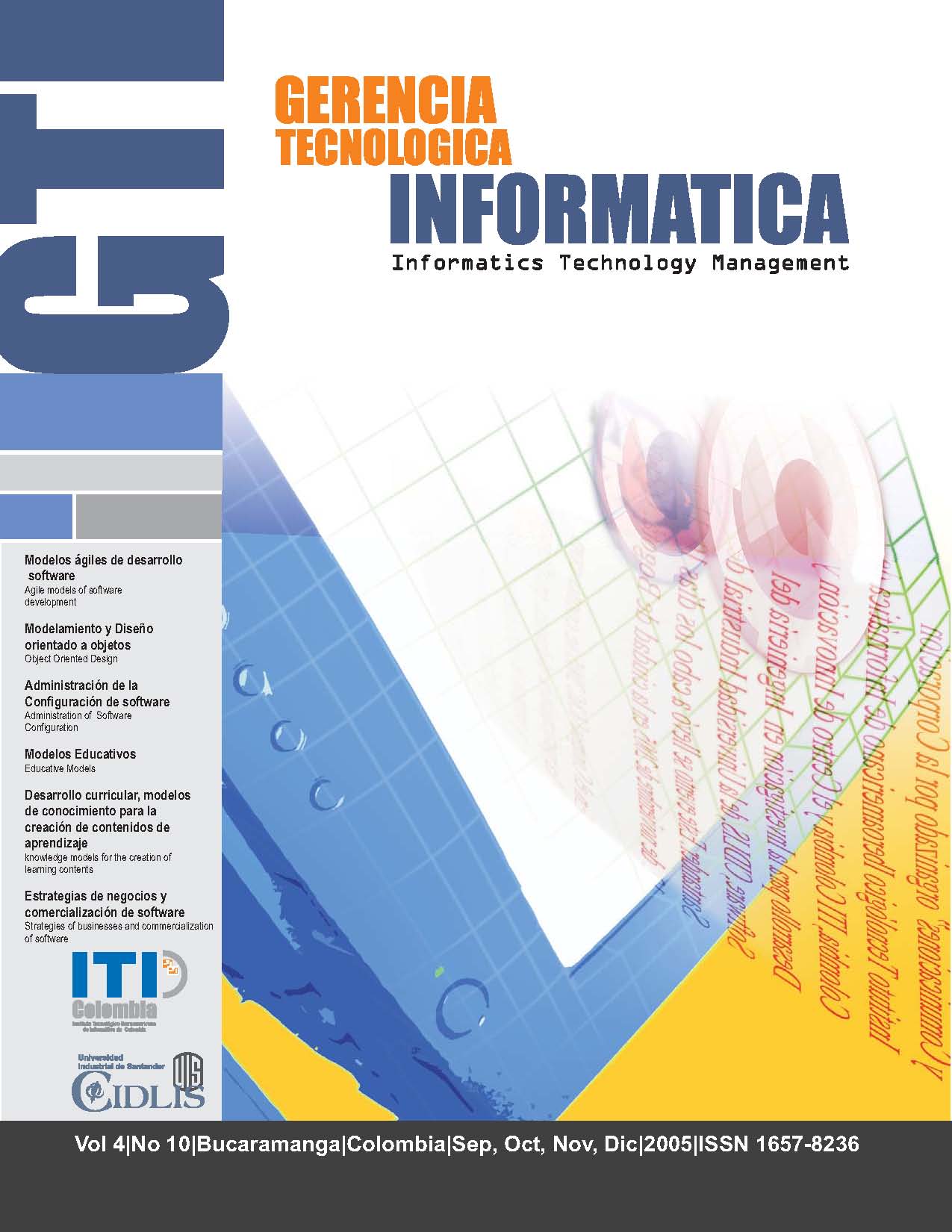CARACTERIZACIÓN Y MODELADO CON UML DE UNA HERRAMIENTA INFORMÁTICA PARA LA GENERACIÓN DE PORTALES DE CONOCIMIENTO ORIENTADO A GRUPOS Y CENTROS DE INVESTIGACIÓN UNIVERSITARIOS
Published 2011-04-14
How to Cite
Abstract
El presente artículo tiene como propósito, presentar la fundamentación y los resultados obtenidos a partir del desarrollo del trabajo de investigación de maestría, “CARACTERIZACIÓNMODELADO CON UML DEUNAHERRAMIENTAINFORMÁTICAPARALAGENERACIÓN DE PORTALES DE CONOCIMIENTO ORIENTADOS A GRUPOS Y CENTROS DE INVESTIGACIÓN UNIVERSITARIOS -PORTAL GCI-”. La estructura del proyecto se centraliza en dos aspectos: Laestión de conocimiento aplicada en grupos y centros de investigación y las arquitecturas para la construcción de portales de conocimiento y; con lo cual se establecen loslineamientosgenerales que permiten el diseño y modelado de la arquitectura del portal para grupos y centros de investigación. El trabajo de investigación consiste en el modelado de una herramienta software que genera portales de conocimiento para apoyar la conversión de conocimiento tácito en explícito, así como la transferencia del conocimiento explícito a través de la organización. A la par, establece una serie de estrategias indispensables para fomentar la gestión del conocimiento al interior de grupos y centros de investigación, de modo tal que la
herramienta opere en condiciones que favorezcan la finalidad para la que será creada, a través del fortalecimiento de la formalización y transferencia del conocimiento, se busca aportar a la continuidad y estabilidad de los grupos y centros de investigación universitarios. La investigación puede ser muy útil a: directores, miembros de grupos y centros de investigación, estudiantes de pregrado y postgrado que se encuentren realizando proyectos que refuercen o fortalezcan la labor investigativa de los grupos a nivel universitario, y en general, a todapersona interesada en la gestión de conocimiento.
PALABRAS CLAVES
Gestión de conocimiento
Arquitectura
Conocimiento tácito y explicito
Aprendizaje
Socialización
Modelado
ABSTRACT
The present article has the purpose, to present the fundamentals and the results obtained from the development of the work of investigation in masters, "CHARACTERIZATION AND MODELLING WITH UML OF A COMPUTER SCIENCE TOOL FOR the GENERATION OF KNOWLEDGE PORTALS ORIENTED TO GROUPS AND UNIVERSITY RESEARCH CENTERS - PORTAL GCI -". The structure of the work of
investigation centralizes in two aspects: The architectures for the construction of knowledge portals and the management of knowledge applied in groups and research centers; with which the general features settle down that allow the design and modeled of the architecture of the portals for groups and
research centers. The work of investigation consists of the modeled of a software tool that generates knowledge portals to support the conversion of tacit knowledge in explicit, as well as the transference of the explicit knowledge through the organization. Also, it establishes a series of indispensable strategies to foment the management of the knowledge in the interior of groups and research centers, of way that the tool operates in conditions that support the purpose for which it will be created, through the fortification of the formalization and transference of the knowledge, looks for to contribute to the continuity and stability of the groups and university research centers. The investigation can be very useful to: directors, members of groups and research centers, students of predegree and postdegree who are making projects that reinforce or fortify the investigative work of the groups at university level, and in general, to all persons interested in the knowledge management.
KEYWORDS
knowledge management
Architecture
Tacit Knowledge
Explicit Knowledge
Learning
Socialization
Modelling
Downloads
References
- Brooking, A. El Capital Intelectual. Barcelona: Paidos Empresa, 1997.
- Nonaka, I. and Takeuchi, H. The Knowledge-Creating Company. How Japanese Companies Create the Dynamics of Innovation. Oxford: Oxford University Press, 1995.
- Krogh, Georg Von. Enabling Knowledge Creation: How to Unlock the Mystery of Tacit Knowledge and Release the Power of Innovation. Oxford: Oxford University Press, 2000.
- Peter Drucker. The Age of Social Transformation. The Atlantic, November, pag 53-80, 1994.
- Bouch, Jan. Design and Use of Software Architecture. Harlow, England: Addison Wesley, 2000.
- Bierstedt, Robert, The problem of Authority, New York: Berger and Abel ed. Freedom and Control in Modem Society, Octagon Books Inc., 1964.
- Larrañaga, Pablo. El concepto de Responsabilidad. México: Editorial Fontamara, 2000.
- Shawn, Mary. Garlan, David. Software Architecture: Perspectives on an enmerging discipline. Upper Saddle River: Prentice Hall, 1996.
- Booch, G.; Rumbaugh, J. y Jacobson,I. El lenguaje Unificado de Modelado. Madrid: Addison Wesley. 1999.
